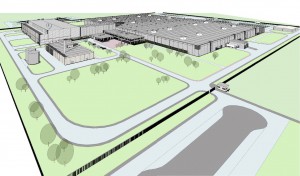
Daimler is opening a new plant in Russia. The new facility, just north of Moscow, is slated to open in 2019.
Daimler AG plans to establish its first passenger car production in Russia at the Esipovo Industrial Park, about 25 miles northwest of Moscow.
The new plant, which will cost 250 million euros, will be built with a flexible production system capable of building both sport utility vehicles as well as the E-Class Sedan cars when the plant opens in 2019.
“Russia is of strategic importance for Mercedes-Benz and an attractive growth market. That is why we expand our worldwide production network with a new plant at Esipovo Industrial Park,” says Markus Schäfer, Member of the Divisional Board of Mercedes-Benz Cars, Production and Supply Chain Management.
“By establishing a local production (facility) we do not only achieve greater proximity to our Russian costumers but also strengthen the international competitiveness of Mercedes-Benz Cars,” he said.
Russia remains one of Mercedes’ strongest European markets despite the sluggish economic climate. Mercedes was the top-selling luxury brand in Russia in 2016 – the fourth consecutive year – with sales of 36,888.
(Jeep sales likely to flatten this year. Click Here for the story.)
Last year’s bestsellers were the E-Class sedan and the SUVs. The company’s sales were down 11%, which matched the decrease for the overall market, according to data from the Association of European Business in Russia.
The new passenger car plant in the Moscow region will comprise all production steps, from the body show through paint shop to assembly. More than 1,000 jobs will be created at the site and further jobs at local service providers and suppliers.
“The investment of Mercedes-Benz in the local production of passenger cars indicates the strategic decision of a global manufacturer and his trust in the Russian market, regardless of the short-term market environment,” said Alexander Morozov, deputy minister of Industry and Trade of the Russian Federation. “This shows the high attractiveness of the Russian automotive industry for investors.”
Daimler has been successfully cooperating with KAMAZ since 2010 to develop the Russian commercial vehicle market. Daimler and KAMAZ each hold a 50% stake in DK RUS.
“We have many years of experience in the production and localization of vehicles in Russia,” said Sergei Kogogin, general manager of KAMAZ.
(Click Here for details about Daimler’s investment in a new financing app.)
“This is why we are planning to continue working with Daimler AG in order to strategically expand our business and thus to further develop international suppliers in Russia,” he said.
Daimler isn’t the only maker finding success in Russia these days. Ford Motor Co. saw its sales grow by 10% in 2016 after three bad years, potentially vindicating its decision to remain in a volatile market when one of its chief rivals, General Motors, abandoned the Russian market.
Sales of cars in Russia have fallen by more than half since a peak of 2.9 million vehicles in 2012, due to an economic crisis brought on by low oil prices and Western economic sanctions that were imposed after a Russian-backed armed uprising is the Ukraine. The market fell by 11% last year, and was down a further 5% in January from a year earlier.
Ford has continued to invest in Russia, launching new models with modifications designed to suit the country’s harsh driving conditions.
Since 2011, its joint venture with Sollers SVAZ.MM, a Russian partner, has invested $1.5 billion into making cars locally to local specifications.
(To see more about Wolfgang Bernhard’s resignation from Daimler, Click Here.)
However, the 40,000 Fords sold in Russia last year are still barely more than a fifth of the almost 190,000 vehicles the company sold in 2008, before the global financial crisis brought the first of two collapses in the Russian car industry in less than a decade.
